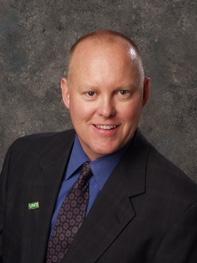Q&A with 2017 CashCourse Educator of the Year

Paul Goebel, Director of the University of North Texas (UNT) Student Money Management Center In the summer of 2005, Paul Goebel had a chance encounter with his school’s vice president of student affairs, which led to his appointment as assistant director of a new campus financial literacy program.
Twelve years later, Goebel still runs the program, which offers peer coaching, about 150 outreach events a year, and robust online personal finance resources, including NEFE’s CashCourse.
NEFE:What are you most proud of in your work in financial education?
Paul Goebel:My greatest point of pride is our peer mentor program. I always envisioned the dynamic engagement we could realize having students serving as peer mentors on our team. It just took us longer to see our dreams turn into realities.
With the funding support of a foundation grant, we were able to pilot a peer mentor program in the fall of 2008. Since that time we have welcomed an incredible cadre of mentors from a variety of degree programs and backgrounds. Our peer mentors bring such creativity and responsibility to their work. They have far exceeded any expectations that I may have had on what I thought peers could accomplish. Our students can walk into any classroom and make an immediate connection with other students. Seeing that immediate connection is inspirational.
I’m also incredibly proud that today all of our marketing materials and social media posts are created by our peer mentors and graduate assistant. Having marketing materials that are both student-centered and student-designed is incredibly rewarding.
NEFE: Do you have any advice for other schools implementing financial education?
PG: When it comes to program development, I live by one mantra: Don’t reinvent the wheel when you can steal the whole cart. There are some incredible best practices in financial literacy/wellness out there. Don’t just respect them, steal them. Bring ideas and materials back to your school as you transition them into a dynamic and diverse program.
My other piece of advice is that one size does not fit all. All students do not learn by one common resource or medium. Any student programming needs to be diverse in message and means. Some students will learn by coming to a presentation, others will learn online, while other students need that one-on-one coaching opportunity. Finding the right combination of programming types and timing is the ongoing challenge and holy grail facing any student service on any campus: How do we connect with all students?
Remember to engage students not only as customers, but also as partners. Students can provide great insights as members of a steering or advisory committee.
Students can provide greater support as mentors and student employees. I truly believe that more than half of the staffing of any campus-based student services office should be represented by student workers. Don’t forget that a good portion of your time will be spent in marketing and promoting your programs.
Financial literacy/wellness programming is still a relatively new concept throughout higher education. You will be competing with all of the opportunities students have on your college campus for their free time outside of the classroom. Find ways to promote your programs and services to students. Use every means of communication channel available. Let students create your marketing materials to cut through the clutter of messaging from other on-campus departments. Be patient and persistent.
Paul’s Three Essentials for a Successful Program
- Senior administration advocacy and buy-in. I was very fortunate to have support from my first day on campus through our then Vice President of Student Affairs, Dr. Bonita Jacobs. Without her support and vision, our center would not have succeeded.
- Teamwork. UNT prides itself on being a student-centered campus. As such I have made a commitment that under my leadership more than half of our team will always be represented by students. I cannot stress enough the incredible creativity, energy and innovation that our student team members bring to our services, programs and events.
- Collaboration. If you are the only person on your campus advocating for your program, I doubt you will be employed for long. It truly takes an entire campus to sustain any type of new programming, especially one that cuts across institutional org charts, divisions and silos. From our first semester we reached out to form collaborations with other departments. We have more than 70 different partnerships this academic year alone with both on-campus departments and off-campus partners. Through this spirit of collaboration we have been able to enhance and expand our services to better serve students.
For more success stories, program information and helpful tips, sign up for the monthly CashCourse e-newsletter at www.CashCourse.org.
